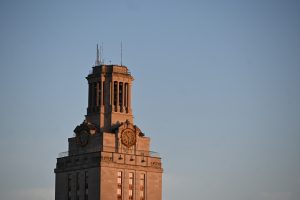UT research shows efficiency of social distancing policies during COVID-19 pandemic
October 18, 2021
A UT researcher found the U.S. did not maintain strong enough social distancing policies in 2020 to prevent long-term COVID-19 spread due to disagreements between states on virus precautions in a collaborative study published last month.
UT, Chapman University and University of Cyprus found that while the U.S. successfully decreased the usage of public spaces at the start of the pandemic in April 2020, crowding increased in these spaces starting in May, contributing to the spread of the COVID-19.
“In some ways the U.S. has done really well … like when it comes to procuring vaccines,” researcher Avinash Collis said. “But then in many other ways, like … when it comes to social distancing policies, what we found is that it didn’t really work in the long term.”
The researchers used SafeGraph, a company that tracks data from over 10 million individuals’ phones to measure how many times people visit a specific location, to conduct the latest study. In addition to tracking, the researchers surveyed 3,000 people to measure social importance of various locations, researcher Seth Benzell said.
“We rank all of these different locations by how good of a trade off they offer,” said Benzell, assistant business and economics professor at Chapman University. “So on one extreme we have banks which are really important to the economy … and if you think about banks they tend to be these really big open spaces that aren’t super crowded most of the time. Gyms are an example of a very bad location … they tend to be sweaty (and) crowded spaces.”
Benzell said people continued to visit various locations when COVID-19 cases surged last winter when different states loosened restrictions. As a result, visits to areas such as sit-down restaurants and department stores increased starting in May. Public spaces such as universities shutdown at the beginning of the pandemic but many students returned to universities throughout the U.S in August 2020 contributing to increased COVID-19 infections.
“Some people said … ‘I would rather have less lockdown because I care less about the danger than I do about whatever benefits I’m deriving,’” Benzell said. “Part of the conversation is always, there’s an external part of this, which is, it’s not just about your own safety, it’s about the safety of the people around you.”
In a study published in June 2020 involving the same researchers, the team concluded that one of the biggest problems the U.S. faced with their social distancing policies was that each state chose different measures and levels of severity at which they’d operate as opposed to other countries like New Zealand that had social distancing policies nationwide, researcher Christos Nicolaides said.
“If there are two states that are in lockdown and there is one state that has orders the other one doesn’t have, maybe there are spillovers from one place to the other place to go to a bar, to go to the supermarket or to go to restaurants.”Nicolaides, assistant business professor at the University of Cyprus, said.
Collis, a business assistant professor, said the study should act as a framework for policymakers to make educated decisions in the future. Collis said throughout the pandemic, government officials have made COVID-19 policy decisions without looking at the data available to them, including information on where people tend to gather and how this impacts spread of the virus.
“(COVID-19) has been a huge event in my life,” Collis said. “Being personally affected by the pandemic definitely made me think hard about ways in which I can contribute to research around the pandemic and that led to this study.”












